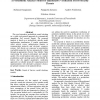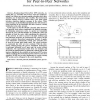218 search results - page 25 / 44 » Preservation of epistemic properties in security protocol im... |
KBSE
2007
IEEE
14 years 1 months ago
2007
IEEE
We present tools to support model-based security engineering on both the model and the code level. In the approach supported by these tools, one firstly specifies the securitycr...
IACR
2011
12 years 7 months ago
2011
We present a method to compile Yao’s two-player garbled circuit protocol into one that is secure against malicious adversaries that relies on witness indistinguishability. Our ap...
COMPSAC
2008
IEEE
14 years 2 months ago
2008
IEEE
This work introduces probabilistic model checking as a viable tool-assisted approach for systematically quantifying DoS security threats. The proposed analysis is based on a proba...
TPDS
2008
13 years 7 months ago
2008
Abstract-- Broadcast-based Peer-to-Peer (P2P) networks, including flat (e.g., Gnutella) and two-layer super-peer implementations (e.g., Kazaa), are extremely popular nowadays due t...
CORR
2006
Springer
13 years 7 months ago
2006
Springer
Although good encryption functions are probabilistic, most symbolic models do not capture this aspect explicitly. A typical solution, recently used to prove the soundness of such ...


